The term human-aware navigation belongs to the categories of artificial intelligence, automation and robots. It describes technologies in which machines such as robots or autonomous vehicles are controlled in such a way that they recognise and take into account the presence, movements and needs of people in their environment.
Human-aware navigation ensures that robots or self-driving vehicles do not simply stubbornly follow their path, but take people into consideration. This means that they slow down, swerve or stop completely as soon as a person gets in their way. This reduces the risk of accidents and makes co-operation between man and machine safer and more comfortable.
An illustrative example is an autonomous delivery robot in an office building. If there is a group of people in the corridor, the robot recognises them with the help of sensors and artificial intelligence. It then chooses a route that causes as little disruption as possible and, if necessary, waits until the way is clear again. Human-aware navigation thus improves the everyday lives of many people and makes modern technologies suitable for everyday use and safe.















